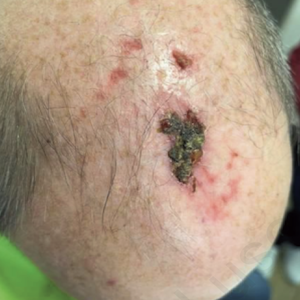Erosive pustular dermatosis of the scalp: a pathogenetic mystery and therapeutic challenge

All claims expressed in this article are solely those of the authors and do not necessarily represent those of their affiliated organizations, or those of the publisher, the editors and the reviewers. Any product that may be evaluated in this article or claim that may be made by its manufacturer is not guaranteed or endorsed by the publisher.
Authors
rosive pustular dermatosis of the scalp (EPD) is a rare condition that affects pre- dominantly the adult population and occurs on a previously photo-damaged bald scalp. The physical examination is presented with large erythematous, erosive and crusted patches with granulation on an atrophic skin. The problem in patients with erosive pustular dermatosis of the scalp arises from the non-specific clinical and histopatholog- ical findings, which can be misleading. Biopsy followed by careful histopathologi- cal verification is mandatory, although the finding is nonspecific. The histopathology findings are characterized by superficial erosions with mild neutrophil infiltrate, mainly intravascular and focally with neu- trophil exocytosis. Focal parakeratosis, smoothed rete ridges without pronounced interface changes. Pronounced lymphoplas- macytic infiltrate with focal distribution in the dermis, giant cell reaction with the for- mation of a “foreign body” granuloma. We report a 58-year-old male patient with a 1- year-old lesion, suspected for skin cancer, later diagnosed with EPDS, which was suc- cessfully treated with topical clobetasol proprionate after 3-5weeks.
How to Cite

This work is licensed under a Creative Commons Attribution-NonCommercial 4.0 International License.








